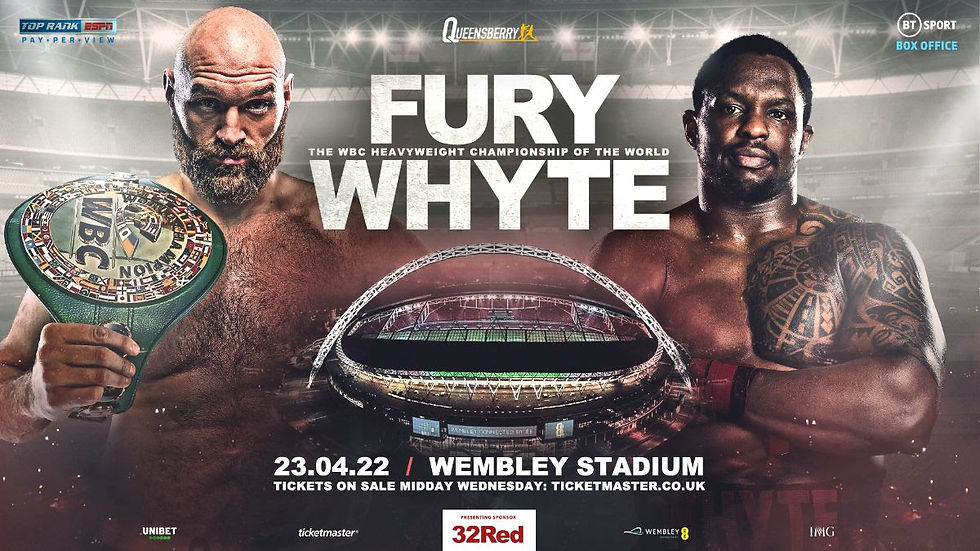Tyson Fury vs Dillian Whyte - The SimBoxx Preview
- SimBoxx

- Apr 17, 2022
- 5 min read

Boxing fans will be in store for one of the biggest all-British heavyweight match-ups in history when Tyson Fury (31-0-1, 22 KO’s) defends his WBC, Ring Magazine and lineal titles against perennial top contender Dillian Whyte (28-2, 19 KO’s) on April 23 at Wembley Stadium in London, UK.
In what will be a record capacity for a sporting event at Wembley Stadium and a British boxing attendance record, the capacity for this fight has been increased to 94,000 to mark the most significant all-British heavyweight bout staged in Britain since Lennox Lewis vs Frank Bruno in 1993.
With Oleksandr Usyk and Anthony Joshua currently otherwise engaged, Fury vs Whyte is the best scrap the heavyweight division can deliver at the present time.
Whyte is getting his first opportunity to fight for a major world title, one that is long over-due. The Brixton heavyweight has been a top contender for a number of years, consistently fighting fellow top contenders, with varied success.
“The Body Snatcher” lost via seventh round knockout to Anthony Joshua back in December 2015, when the two Brits were operating at British level, prior to Joshua becoming a unified champion. This loss prompted Whyte to change his training regime and take his boxing to the next level.
By July 2018, Whyte had vastly improved and scored arguably his most significant victory, a unanimous decision against former WBO champion, Joseph Parker. He followed this win with a devastating 11th round knockout of Dereck Chisora and a unanimous decision against then-undefeated Oscar Rivas. Other victories have been against Robert Helenius and Mariusz Wach, and an immediate rematch win against Alexander Povetkin.
Whyte does not have the best resume in today’s heavyweight division, but he definitely has one of the better ones.
Fury is seen by some as an all-time great in the making, which means a fight like this is necessary to get a better understanding of his standing in history. Whyte is only Fury’s third elite-level opponent. Those marvellous wins against Wladimir Klitschko and Deontay Wilder are as good as any wins by a British fighter in history, but the simple fact remains, as things stand, Whyte has fought more world-class opponents throughout the course of his career.
Fury has shown characteristics and qualities of greatness. They just have to be shown in more fights and more consistently, whilst defending his titles, to be considered an all-time great.
Fury defeated two long-reigning champions, with 10 or more title defences, in their own backyards. With the highest possible stakes, Fury exhibited qualities which can be associated with greatness, showing tremendous heart and recuperative powers to defeat hard-hitting Wilder twice to produce two of the most impressive heavyweight victories in recent years.
Whyte has yet to show those qualities at the highest level which point to greatness, but this may not be due to a lack of talent and quality, but rather opportunity.
Whyte has serious power, an underrated jab, is a great body puncher, has heart and guts, astounding will to win, strength, and mixes his shots to head and body as well as anyone in today’s heavyweight division.
Beating Klitschko in Dusseldorf, then going to war more than once against Wilder and prevailing shows that Fury has a lot of heart and mental strength, but so does Whyte.
When Whyte faced Povetkin in August 2020, he took an uppercut that knocked him flat on his back and rendered him unconscious. Under any circumstances, this is a fate that can be difficult to overcome. How did Whyte respond? He demanded an immediate rematch as soon as possible, then showed absolutely no signs of being gun shy, immediately taking the fight to the Russian with aggression, and beat him up en route to a 4th round stoppage. Although Povetkin was woeful, the mentality and guts showed by Whyte was commendable.
Fury is a huge favourite heading into this fight, but as Sugar Ray Robinson once said: “To be a champion you have to believe in yourself when nobody else will.”
The excitement of heavyweight boxing lies in that any man can be hurt and dropped. Granite-chinned heavyweights like George Chuvalo, Vitali Klitschko and Oliver McCall who never touched the canvas are in the extreme rarity. Big, powerful men exchanging leather means no-one is safe.
Whyte has shown vulnerability in being knocked down and knocked out before. He was knocked out by Joshua and Povetkin, and very nearly stopped by Parker. Even now, at 34, Whyte still looks like he is learning on the job.
Make no mistake, Fury is just as vulnerable. Being dropped six times as a professional, four times against Wilder, shows this. For a reigning world heavyweight champion, Fury has touched the canvas a lot. Despite his general elusiveness, Fury is prone to moments of lacking focus, even in the grandest of occasions. If Whyte does land, which seems almost certain to happen, he has finishing abilities that Wilder lacked. Wilder generally ended his opponents with one-hitter quitters. When the opponent survived, the aftermath on Wilder’s part looked very messy at the best of times.
The thing with Fury is, he has showed the ability to survive. He can be put down, but he always gets back up, and seems almost immediately clear headed, with strong legs under him, and ready to keep fighting. Fury can be hurt. It’s keeping him hurt which seems to be the challenge. Nevertheless, styles differ, and Whyte is no Wilder. Fighting Whyte in the same manner can be very dangerous. He is a different opponent who requires a different game-plan.
Under SugarHill Steward’s guidance in his last two fights against Wilder, Fury ‘went to war’, adopting the Kronk style, applying pressure behind a consistent and rangy jab to set up the big right hand, and leaning on the opponent on the inside, making them carry the weight, in Fury’s case nearly 300 pounds, and sapping their energy.
Is Fury’s game-plan henceforth entirely down to choice? Does Fury still have the legs of old? Is the new more aggressive style completely down to the Kronk style adopted with SugarHill Steward, or is Fury also adapting to his older, ageing body?
Surely a more aggressive Fury, as opposed to vintage Fury where he was utilising movement and outboxing opponents, gives Whyte a far better chance of winning?
Father Time catches up with the most dedicated of athletes. Perhaps Fury has no choice but to spend more time going toe-to-toe and less time utilising movement. Or, as he has already done in his career, he can defy logic to show he still has the same athleticism and movement as before, utilising it en route to a routine win against ‘The Body Snatcher’.
One factor that adds further intrigue to this fight is the Kronk connection. Whyte added Harold “The Shadow” Knight to his corner for the Povetkin rematch. Knight worked alongside Manny Steward, the legendary mastermind of the Kronk style, in the corner during Lennox Lewis’ dominant reign, and the injection of some Kronk Gym fire resembles Fury’s link-up with SugarHill Steward, Manny Steward’s nephew, ahead of the second Wilder fight.
Whether this will have a bearing on the result of this fight is yet to be seen, but Knight is someone who will be very familiar with the style which has brought Fury so much success recently, having worked alongside the creator of it for years.
The last time there was two British heavyweights, bad blood involving lawyers, a WBC heavyweight title and it was outdoors, we got a special fight involving Lewis and Bruno in October 1993 in Cardiff.
If Fury and Whyte produce something similar on fight night, we are in for a treat.
By Sina Latif of SimBoxx
Twitter - @_sina93








Comments